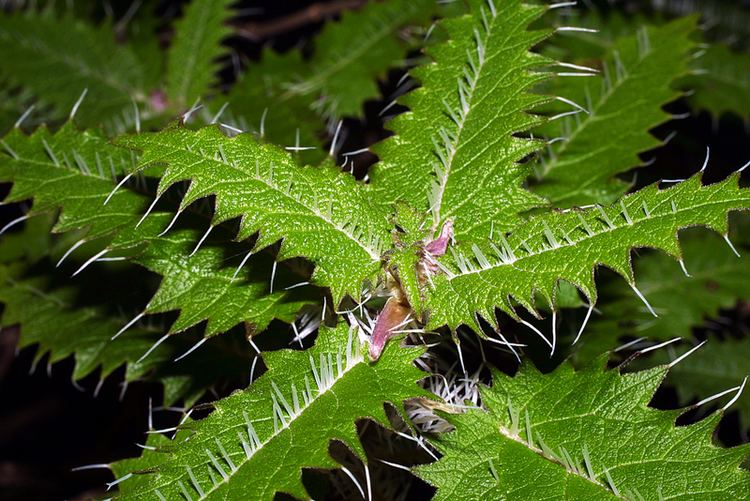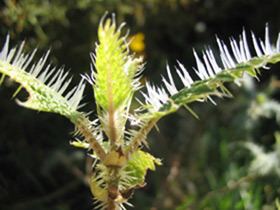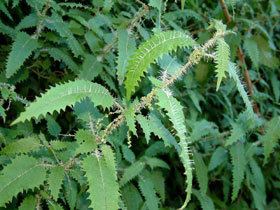Rank Species | Higher classification Nettles | |
 | ||
Similar Nettles, Urticaceae, Urtica incisa, New Zealand red admiral, Urtica atrovirens | ||
Urtica ferox, commonly known as Tree Nettle, or ongaonga in Māori, is a nettle that is endemic to New Zealand. It is sometimes known as "Taraonga", "Taraongaonga" or "Okaoka". Unlike other herbaceous species in the Urtica genus, ongaonga is a large woody shrub. It has woody stems and unusually large stinging spines that can result in a painful sting that lasts several days. The shrub can grow to a height of 3 m (9.8 ft) with the base of the stem reaching 12 cm (4.7 in) in thickness. The pale green leaves are very thin like a membrane, the surface of the leaf, stems and stalks are covered in stiff stinging hairs can grow up to 6 mm (0.24 in) long. These spines are prominent along the salient mid-vein and leaf margin. The leaves range from 3–5 cm (1.2–2.0 in) in width and 8–12 cm (3.1–4.7 in) in length, these are oppositely arranged and there are two stipules per node. The leaf shape is ovulate-triangulate with a serrated leaf margin each bearing a spine of up to 1 m (3 ft 3 in). The spines covering the leaf surface, stem and stalk are generally no larger than 6 mm (0.24 in) in length, the spines on the older darker bark are smaller and softer, these don't cause a sting. This nettle is winter deciduous in cold climates, evergreen in mild climates and can lose its leaves in drought conditions if it is growing in shallow soils.
Contents
- Distribution
- Life cyclephenology
- Diet and foraging
- Predators parasites and diseases
- Cultural uses
- References

The toxin present in the spines is triffydin (or tryfydin). This toxin contains histamine, serotonin and acetylcholine, the last of which causes powerful stimulation of the parasympathetic nerve system. Multiple stingings can have a very painful reaction which causes inflammation, a rash, itching, and in high concentrations loss of motor movement, paralysis, drop in blood pressure, convulsions, blurred vision and confusion. The toxin from 5 spines is enough to kill a guinea pig.. There has been one recorded human death from contact—a lightly clad hunter who died five hours after walking through a dense patch. Acute polyneuropathy can occur due to U. ferox stings.

In Māori folklore, Kupe was said to have placed several obstacles to hinder pursuers whose wives he had stolen, one of which was the ongaonga.

Ongaonga is the main food plant for larvae of the New Zealand red admiral butterfly or kahukura, Vanessa gonerilla.

Distribution

The tree nettle is an endemic species to New Zealand which inhabits sub-tropical and temperate regions, the plant is very common in the North Island but limited in the South. In the South it's commonly found on the West Coast and on Banks Peninsula, the plant is not commonly found east of Otago where the climate is much drier. The tree nettle can also be found on Stewart Island. The shrub commonly inhabits coastal and lowland areas at altitudes between sea level and 600m above sea level. It can be found on its own or in dense thickets and is often found growing along forest margins. It prefers well lit environments so suits stock damaged bush, in tree fall gaps and on steep and unstable slopes.
Life cycle/phenology
Among the periods of November to March, the tree nettle flowers. Because the tree nettle is a dioecious shrub, it will cross pollinate. The pollen of male flowers can transfer to the female flowers through wind. These pollen grains can be collected by female dense stigmas. When pollen arrives in the female flowers, the pollination of female flowers will begin. Then in January, the fruit of tree nettle mature. The seed of tree nettle is one and half millimeters long and brown color, ovoid shape like. When the seed is planted in the environment which has more light and water, it will take one month to germinate. One study found that the seeds germinate after one month in soil, the seeds germinate throughout winter and spring of the year they are dropped. In this study cited out of the 5 different Woody seeding species Urtica ferox had the lowest germination rate of 59% compared to >85% of the other similar species, the author surmise that Tree Nettle is capable of building up a large seed bank in the soil which will survive for 5 – 15 years.Seed dispersal is carried out by rolling, wind and in the gut of birds, the seeds are achenes and are surrounded by a persistent perianth which contribute to the long lived seed bank it produces. This is important for the ecological niche that it inhabits, we can surmise that it doesn’t do well competitively with the other species in its environment due to its growth on boundary zones, an adaption for long lived seed banks are therefore advantageous as it must wait for clearing and collapse of the larger dominating species before it can take hold.
Diet and foraging
The tree nettle requires high nutrient levels found in cycling forest systems such as beech forest and native New Zealand forest. In these environments an “A type” soil horizon of rich leaf litter and humus between 10 – 80 cm is common. This is significant as the species doesn’t directly compete with other flora, this is achieved through inhabiting the boundary zones between strata, therefore the high soil fertility, like other species in the nettle family, grows well in soils with high nutrient levels, especially high quantities of nitrogen and access to open sunlight and rainwater results in a rapidly growing plant able to take advantage of natural tree fall and other natural events such as land slides and flooding which clear dominating old growth species.
Predators, parasites, and diseases
Although tree nettle is a toxic shrub, it also play a significant part in the phenology of a local butterfly, namely the red admiral (Vanessa gonerilla). The leaves of the tree nettle is the preferred food and provide protection for the butterfly larvae. When the larvae arrives in the leaves, it will curve the tip of nettle leaf, use the silken threads to make the leaves stick together, and constructs a secure place where they can eat the food. Due to the caterpillar's activities, the leaves of shrub can fall off. The eggs of butterflies, also including the yellow admiral (Vanessa itea), are laid on the leaves of nettle during the spring and summer. It takes eight to ten days for the eggs to incubate. Beside these butterflies, some mammals also eat the leaves of tree nettle, like the Common brushtail possum, goats and deer. However, because no native non-flying, non-marine mammals existed in New Zealand prior to human arrival in the last one thousand years, the tree nettle would have been without mammalian predators in its evolutionary history until quite recently.
Cultural uses
In the Māori culture, tree nettle plays an important role in the people’s lives. For example, it can be used in medicine,. and food. Māori use the bark of tree nettle and the leaves of kawakawa, boiled together, to make a liquid that can be used internally and externally for eczema and venereal disease. Also, the leaves of tree nettle play a significant part in the treating pains. The decoction of leaves and youth twigs dip in boiled water is said to have a benefit on stomachache and on the treatment of gonorrhea. It is also commonly documented that Urtica ferox was a food source for Māori. The inner stems were sometimes consumed after the leaves and outer bark had been removed, the thin film that makes up the inner bark was also eaten raw and is said to have a sweet taste, it is also documented that stems were cooked after having the leaves removed.
